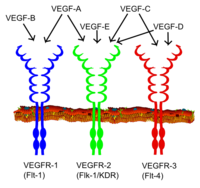
Photo from wikipedia
Transport of newly synthesized lysosomal enzymes to the lysosome requires tagging of these enzymes with the mannose 6‐phosphate moiety by UDP‐GlcNAc:lysosomal enzyme N‐acetylglucosamine‐1‐phosphotransferase (GlcNAc‐1‐phosphotransferase), encoded by two genes, GNPTAB and… Click to show full abstract
Transport of newly synthesized lysosomal enzymes to the lysosome requires tagging of these enzymes with the mannose 6‐phosphate moiety by UDP‐GlcNAc:lysosomal enzyme N‐acetylglucosamine‐1‐phosphotransferase (GlcNAc‐1‐phosphotransferase), encoded by two genes, GNPTAB and GNPTG. GNPTAB encodes the α and β subunits, which are initially synthesized as a single precursor that is cleaved by Site‐1 protease in the Golgi. Mutations in this gene cause the lysosomal storage disorders mucolipidosis II (MLII) and mucolipidosis III αβ (MLIII αβ). Two recent studies have reported the first patient mutations within the N‐terminal transmembrane domain (TMD) of the α subunit of GlcNAc‐1‐phosphotransferase that cause either MLII or MLIII αβ. Here, we demonstrate that two of the MLII missense mutations, c.80T>A (p.Val27Asp) and c.83T>A (p.Val28Asp), prevent the cotranslational insertion of the nascent GlcNAc‐1‐phosphotransferase polypeptide chain into the endoplasmic reticulum. The remaining four mutations, one of which is associated with MLII, c.100G>C (p.Ala34Pro), and the other three with MLIII αβ, c.70T>G (p.Phe24Val), c.77G>A (p.Gly26Asp), and c.107A>C (p.Glu36Pro), impair retention of the catalytically active enzyme in the Golgi with concomitant mistargeting to endosomes/lysosomes. Our results uncover the basis for the disease phenotypes of these patient mutations and establish the N‐terminal TMD of GlcNAc‐1‐phosphotransferase as an important determinant of Golgi localization.
Journal Title: Human Mutation
Year Published: 2020
Link to full text (if available)
Share on Social Media: Sign Up to like & get
recommendations!